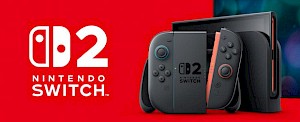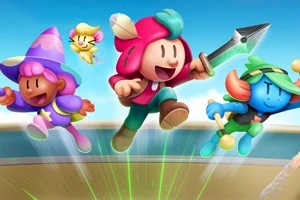Feature: Touch And Go!
Posted 13 Oct 2004 at 23:14 by guest
A closer look at the DS: the dual screens

Welcome to the first instalment in a short series of articles that will be looking as in depth as possible at the Nintendo DS. It will be a happy little fortnightly article which will be followed up the next week by a news roundup article.
After the current wave of new information regarding the NDS, we felt it important to share all the information we have. Some of you are perhaps a little behind on the news or simply don't quite understand how certain aspects will work. Well that's what this little article is all about so please read on below to find out more than you could have ever wished.
Today we're going to be looking at the Dual Screens and their unique styling. Now it is very obvious that the NDS has two screens. What some of you may not know is that one screen has touch screen capability; in fact it is the bottom screen. The touch screen can be controlled by either the stylus pen, which will be hidden very neatly away at the back of the DS, or by your very own finger. In all actuality anything can be utilised for this unique feature, but Shigeru Miyamoto, creator of such classic gaming heroes as Mario and Link from the Legend of Zelda, prefers to use a very soft cotton bud as it won't damage the screen. He really needn't worry as the screen is made from very tough and durable material so using the stylus pen should do.


Touch sensitivity. And this is just the beginning
How the touch screen can be implemented is completely up to the designer of the games, there are no boundaries what so ever. One fine example is the original E3 demo of Metroid Prime: Hunters. You would be able to control the character by using the D-Pad to move forward and back, but then you would use touch screen to move Samus Aran (the game's heroine) left, right, up and down just by simply moving the pen around the screen. Also if you were to tap the screen you would then fire upon the enemy. Another example is the latest and probably cutest game by Nintendo (excluding Pikmin), Nintendog, or now recently known as Puppy Times. You get to interact with the puppies by throwing a Frisbee, or even by making them jump over a skipping rope. This is all done by once again moving the pen over the screen to move the skipping rope around and around or to throw the Frisbee in the direction you move it.
Although having two screens may seem like complicating matters, it has the capacity to simplify the presentation of games. All those menues and icons and whatnot can be shoved out of the way, onto the other screen, leaving the other one clear for actual game-playing, simply requiring you to glance up every once in a while. So far we've seen tentative steps with this with Metroid Prime and Mario 64x4, although it certainly offers more than just a place for a map. Except smarter use of this in the future, especially for info-heavy genres like RPGs and strategy games.
Who here had to turn their TV on its side when playing Ikaruga, because it just didn't feel right otherwise? The two vertical screens make the DS perfect for scrolling shooters or falling-block puzzle games - you can see the results for yourself with Namco's Mr. Driller title. Everything just looks so much clearer with the two screens used as a single vertical one. Let's hope for some experimentation with that prospect.
The most exciting part though is the touch-sensitivity of the second screen. The physicality of it breaks down a lot of the space between the gamer and the game, allowing arguably a truer level of interactivity. The greatest example of this is WarioWare Inc., not surprising since the sparadic and outlandish nature of the game suits experimentation in whatever form it takes. The food-chopping mini-game in it is just a glimpse at what touch-sensitivity offers. Be excited.
In order to power these two screens effectively Nintendo decided to incorporate two chips. The one chip is the ARM 9, a nice little number which can provide some really crisp 3D graphics, the other being the ARM 7. Now why incorporate 2 chips which are different from each other, well the answer is indeed quite simple. The chip that was used within the Game Boy Advance was the ARM 7 and this now allows the DS to play GBA games without the use of any emulators. As the DS has no emulators it does mean that you will not be able to play any of the older Game Boy games, just the GBA's. One down side to playing the GBA games on the DS is that it is completely wireless. You can not play any multiplayer games on it, so hard luck to any Pokemon fans out there, unless of course you buy the next Pokemon game for the DS.


Now this is what we're talking about
Now due to the fact that only the ARM 9 chip can display 3D graphics, it does mean that only one screen can display these beautiful visuals at a time, but if the game requires it, the action can jump from 3D on the top screen to 3D on the bottom. An example of this was displayed in one of Nintendo's E3 tech demos. Pikachu could be happily sat down by the river with his fishing rod out in the water when a fish latches on. The little yellow fella fights until he actually lands the fish, at this point he travels on to the bottom screen where the 3D and 2D graphics happily swap over to show you up close and personal what he landed.
The screen size seem to be appearing at just over the size of the GBA and tally in at a nice 3 inches each and are both backlit, unlike the GBA SP which was front lit and gave off a strange blue glow. As relaxing as it was it took away the atmosphere in certain games where they were looking for a black background. Of course the advantage of the light is that it does allow for sneaky game sessions when your parents think you have gone to bed.
When Nintendo decided to make the DS, their first idea was to have the two screens horizontal, as in side by side. They then released the information to the public about it and people were surprised and shocked and were not quite sure how to react. Then finally E3 came round and the first pictures of the DS were shown and a hold load of new information. More shock but this time plenty of happy smiles on faces and also the revelation of the new screen arrangement, the now commonly known vertical design.
Well that's it for this week, come back in two weeks for the next instalment of DS: Touch and Go. And be sure to look out for the news roundup next Wednesday (there's a lot to get through...).
DS Launch Countdown: 39 days and counting...






















